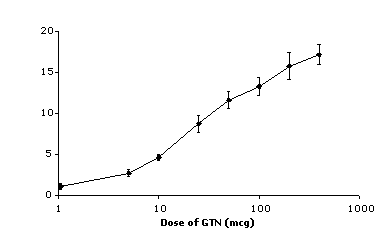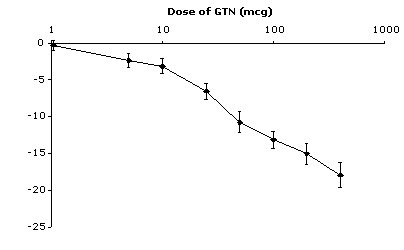| pA2 online © Copyright 2004 The British Pharmacological Society |
200P
GKT, University of London Winter Meeting December 2003 |
|
The dose
response relationship of sublingual GTN to brachial artery diameter
and change in augmentation index |
|
Introduction: Assessment of flow-mediated dilatation (FMD) of the brachial artery is widely performed as a measure of endothelial function. Sublingual GTN is commonly used as the endothelium-independent vasodilator control in these studies. However, the dose of GTN used varies between investigators. The use of lower doses has recently been justified on the basis that these produce a dilatation that more closely approximates to that which occurs during FMD. However, the full relationship between GTN dose and brachial artery dilatation has not been published. Sublingual GTN is also used as an endothelium-independent control in studies that measure endothelial function as the reduction in central aortic augmentation index (AIx) that occurs with inhaled salbutamol. The most appropriate dose of GTN for these studies has also not been determined.
Aim: To characterise the dose-response relationship of sublingual GTN to brachial artery dilatation and reduction in AIx in healthy subjects.
Methods: Seventeen healthy men (mean age 40 years) were recruited to this randomised, double blind, placebo-controlled 9-way crossover study. Each subject received placebo (water) on 2 occasions and single doses of 5, 10, 25, 50, 100, 200 and 400 mcg GTN. Three doses were given in any single day, with a 2-hour interval between each dose.
The brachial artery was scanned using ultrasound from 1 min before until 10 min after each dose. Images were fed into a computer for analysis of diameter using automatic edge detection software. AIx was measured before and 5 min after each dose using the Sphygmocor® apparatus.
Results: Figure 1 shows the relationship of GTN dose and brachial artery dilatation and Figure 2 that of GTN dose and change in AIx.
Figure 1

Figure 2

Discussion: Normal FMD of the brachial artery is generally around 10%, for which the equivalent dose of GTN in this study is approximately 35 mcg. A normal change in AIx with salbutamol is also around 10%, for which the equivalent dose of GTN in this study is approximately 44 mcg. Provided that it is accepted that the dose of GTN that should be used as an endothelium-independent control should be equivalent to the endothelium-dependent stimulus, the doses of GTN suggested in this study should be used in endothelial function studies using FMD and the salbutamol/AIx technique.